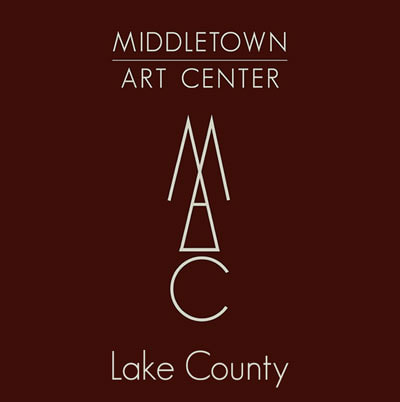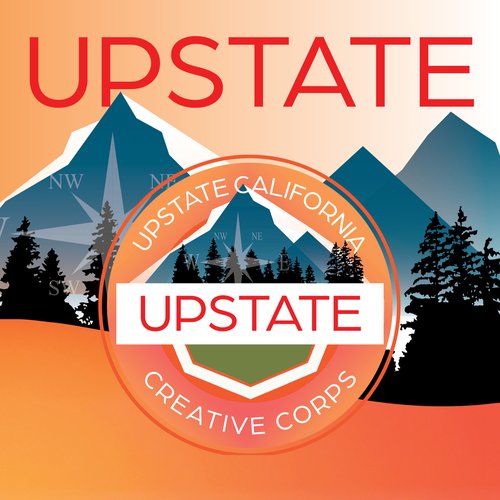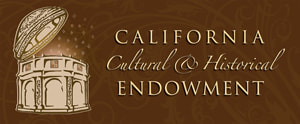ECHOES OF THE LAND Lorraine Triana Rueda (left)
TSÚKLI - TO SHINE FORTH and by Trelasa Baratta (right)
WATER BASKET
The Water Baskets pay tribute to the cultural legacy of the original stewards of this land, and to the Indigenous flora and fauna of the Middletown area, known in Kóotsa-ataw as “Wiilokyomi” – Dusty Place.
The Water Basket project reflects the unification, regeneration, and revitalization of the Middletown community as a whole, post Valley Fire. Water is Life.
The Water Basket project reflects the unification, regeneration, and revitalization of the Middletown community as a whole, post Valley Fire. Water is Life.
Following the devastating Valley Fire of 2015, the two water tanks on Rabbit Hill, atop the highest point in Middletown, were made very visible through burned tree skeletons surrounded by scores of homes that had burned to the ground. It became clear that in beautifying the tanks, Callayomi Water District could contribute to community recovery and renewal. The Middletown Art Center (MAC) approached the Water District to propose 360° murals.
Designs inspired by Pomo basket patterns with their strong negative positive shape relationships and symbolic geometry, would be legible from afar and honor the cultural heritage of the original people of this place. Pomo Basketry is renowned worldwide for excellence in aesthetics, craftsmanship and form and function. The design patterns are reflective of the natural world, and rooted in this place. MAC approached the Tribe for concept approval, guidance and collaboration, and the Water Basket project was born.
The Water Basket project is a collaboration between Middletown Rancheria of Pomo Indians, of California,Callayomi County Water District, and the Middletown Art Center (MAC). The project is funded in part by an award from the National Endowment for the Arts, with additional funding from the Middletown Rancheria, the Water District, Calpine at The Geysers, and Lake County Tribal Health Consortium.
Following MAC's receipt of a grant award from the National Endowment for the Arts for the project, a symposium on Pomo Basketry design was held followed by three workshops led by Pomo artists Corine Pearce, Meyo Marrufo, and Eric Wilder to introduce, inform and create designs with Pomo basket design patterns (videos linked below). A Call for Work went out and roughly 20 designs were considered by a jury of 12 representing various communities/organizations in Middletown selected 6 designs to move forward to public input. Public input took place at a well-attended Middletown Area Town Hall meeting. Design models were available for public consideration at MAC and the Water District office for three weeks (see call for work and the 6 designs that moved to public input below). Two designs were selected to move forward for implementation.
Designs inspired by Pomo basket patterns with their strong negative positive shape relationships and symbolic geometry, would be legible from afar and honor the cultural heritage of the original people of this place. Pomo Basketry is renowned worldwide for excellence in aesthetics, craftsmanship and form and function. The design patterns are reflective of the natural world, and rooted in this place. MAC approached the Tribe for concept approval, guidance and collaboration, and the Water Basket project was born.
The Water Basket project is a collaboration between Middletown Rancheria of Pomo Indians, of California,Callayomi County Water District, and the Middletown Art Center (MAC). The project is funded in part by an award from the National Endowment for the Arts, with additional funding from the Middletown Rancheria, the Water District, Calpine at The Geysers, and Lake County Tribal Health Consortium.
Following MAC's receipt of a grant award from the National Endowment for the Arts for the project, a symposium on Pomo Basketry design was held followed by three workshops led by Pomo artists Corine Pearce, Meyo Marrufo, and Eric Wilder to introduce, inform and create designs with Pomo basket design patterns (videos linked below). A Call for Work went out and roughly 20 designs were considered by a jury of 12 representing various communities/organizations in Middletown selected 6 designs to move forward to public input. Public input took place at a well-attended Middletown Area Town Hall meeting. Design models were available for public consideration at MAC and the Water District office for three weeks (see call for work and the 6 designs that moved to public input below). Two designs were selected to move forward for implementation.
The artist for the tank seen left above is Trelasa Baratta . “I come from the Chappo and Knight families of Middletown Rancheria. My grandpa Mace was born and raised in Middletown, CA," she shared. They tell me my great uncle Jimmy used to live up on Rabbit Hill, where the water tanks stand today. Uncle couldn’t afford to continue paying the land tax, so he had to give it up, a stark reminder of our community’s struggles.”
"I dedicate my designs to my Grandpa Mace and his brother, Uncle Jimmy, who embodied two distinct yet intertwined worlds. One was an Indigenous world, where all things are treated with respect and gratitude, and where the original language of this place, Kóotsa-ataw, endures—perhaps one day to thrive again. The other was a Western world, one that has not been kind to the original stewards of this land—a world that imposed itself upon us and continues to challenge our very existence, often seeking to replace the Indigenous one.
"I dedicate my designs to my Grandpa Mace and his brother, Uncle Jimmy, who embodied two distinct yet intertwined worlds. One was an Indigenous world, where all things are treated with respect and gratitude, and where the original language of this place, Kóotsa-ataw, endures—perhaps one day to thrive again. The other was a Western world, one that has not been kind to the original stewards of this land—a world that imposed itself upon us and continues to challenge our very existence, often seeking to replace the Indigenous one.
|
Trelasa’s design pays tribute to her cultural legacy, incorporating personal variations of common Pomo basketry patterns. She explains, “I made sure to include Tsokóoko, or Quail, someone deeply significant to our people. I think about Uncle Jimmy enjoying an evening beer and watching their head plumes peek out from behind the bushes.
"My grandpa and great uncle walked the delicate line between these two worlds: one holding steadfast to the Indigenous way of life, and the other navigating survival through assimilation. This project represents the meeting point of these worlds—an evolution of California's history. It is a space where the past is honored, and the best of both worlds come together to forge a path forward." |
The second design (right) selected is by Graphic Designer Lorraine Triana Rueda. Originally from Columbia, Lorraine has lived in California for 6 years and moved to Lake County recently.
"It has been an incredible honor to be part of this project. “Being involved in creating this mural has not only allowed me to contribute to the community but has also enriched my understanding of the local cultural heritage and deepened my connection with the environment around me.I am grateful for the opportunity to have been part of something that brings the community together and celebrates our shared story."
Describing her inspiration and results of her research Lorraine stated, "This mural is a collective canvas that unites the community's profound respect for the land with its rich heritage, weaving a narrative that links past and future while inviting shared guardianship of our history and habitat. The patterns on the top of the tank symbolize the threads that connect the Pomo people to nature and the mutual respect between humans and animals. Arrowhead motifs are a testament to the people of the land, while the central zigzag, evoking deer backs and crow feet, honors the fauna that roam the terrain. Additionally, the triangles represent pine trees or pine cones, further enriching the natural symbolism.
"It has been an incredible honor to be part of this project. “Being involved in creating this mural has not only allowed me to contribute to the community but has also enriched my understanding of the local cultural heritage and deepened my connection with the environment around me.I am grateful for the opportunity to have been part of something that brings the community together and celebrates our shared story."
Describing her inspiration and results of her research Lorraine stated, "This mural is a collective canvas that unites the community's profound respect for the land with its rich heritage, weaving a narrative that links past and future while inviting shared guardianship of our history and habitat. The patterns on the top of the tank symbolize the threads that connect the Pomo people to nature and the mutual respect between humans and animals. Arrowhead motifs are a testament to the people of the land, while the central zigzag, evoking deer backs and crow feet, honors the fauna that roam the terrain. Additionally, the triangles represent pine trees or pine cones, further enriching the natural symbolism.
|
"The design around the tank is inspired by Pomo basket patterns, featuring the bear claw to show each cardinal point (North, South, East, West) and a set of triangles at the bottom representing the turtle's back, an ode to slowing down and truly absorbing our surroundings. The composition includes Middletown's natural residents—key animals significant to the environment, and Pomo culture: deer, rabbit, red-tailed hawk, black bear, flicker, and valley quails. Each element actively participates in the region's ecological tapestry, symbolically integrated to emphasize the deep connections between the Pomo people's cultural heritage and the natural environment, enhancing the traditional craft and contemporary message of the composition."
|
The selection process for the mural designs was comprehensive and inclusive. After careful consideration of over 20 designs, a jury of 14 local stakeholders—including community members, the Middletown Area Merchants Association, the Water District, Middletown Rancheria of Pomo Indians of California, Cultural Educators, Middletown Area Town Hall (MATH), and MAC—chose six designs. These designs were then presented for public voting at four locations: the Water District (open weekdays), MAC (open weekends), a well-attended MATH meeting, coinciding with a County of Lake planning meeting hosted by MATH, and a Middletown Rancheria general meeting (Tribal).
Now, with the designs finalized, the painting phase has commenced under the skilled hand of Xavier Piña, owner of West Coast Painter. Xavier, who has been painting since 1999, moved to Lake County 20 years ago from Los Angeles. He has made significant contributions to the local art scene, including painting the first two murals in Lake County 14 years ago, one of which still adorns the water tank in Clearlake Oaks.
Now, with the designs finalized, the painting phase has commenced under the skilled hand of Xavier Piña, owner of West Coast Painter. Xavier, who has been painting since 1999, moved to Lake County 20 years ago from Los Angeles. He has made significant contributions to the local art scene, including painting the first two murals in Lake County 14 years ago, one of which still adorns the water tank in Clearlake Oaks.
|
“It’s a daunting project, but years of experience give me the confidence to tackle such a feat,” says Piña. Known for his charming and personable nature, he approaches this project with a blend of enthusiasm and expertise. For the Water Basket project, Xavier and his crew had to employ “Egyptian style” techniques, using ropes, radii, and markers to lay out the intricate design. His carpentry skills have been invaluable, as the project requires precise measurements and strong math skills to handle the many angles involved. Despite the summer heat, the team follows the shade around the water tank to stay cool, noting that the tanks themselves are surprisingly cool to the touch. Reflecting on his large-scale painting projects, Xavier remarked, “It’s like they just naturally flow out of me.”
|
Pat Giacomini from the Callayomi County Water District Board of Directors shared her excitement about the project: "At the time the Callayomi County Water District was preparing for maintenance painting on the District’s water tanks at the top of Rabbit Hill, we were offered a unique opportunity to participate in the 'Water Basket' mural collaborative project, which included grant funds for the mural painting. Art and cultural history will come together in this project on the CCWD water tanks, which are located at the highest point in the center of town.
“I have participated in many local beautification and community projects over the years, and I believe this Water Basket project will be an outstanding (literally) statement to the uniqueness of our community. From the beginning, our whole Board and Staff were very excited about partnering with the MAC and the Pomo native historians and artists to develop this idea.
"I love the use of the imagery and cultural indigenous peoples’ symbols in such a dynamic way, as will be seen from vantage points entering town. The murals will not only feature dynamic cultural symbols but also familiar representations of the animals native to our south Lake County area. Many local residents were consulted to bring the designs alive. The MAC has worked for years to engage our community in various ways to better understand the native culture we live with and that will be represented by the murals. I am excited and proud to have been a small part of this beautiful project."
“I have participated in many local beautification and community projects over the years, and I believe this Water Basket project will be an outstanding (literally) statement to the uniqueness of our community. From the beginning, our whole Board and Staff were very excited about partnering with the MAC and the Pomo native historians and artists to develop this idea.
"I love the use of the imagery and cultural indigenous peoples’ symbols in such a dynamic way, as will be seen from vantage points entering town. The murals will not only feature dynamic cultural symbols but also familiar representations of the animals native to our south Lake County area. Many local residents were consulted to bring the designs alive. The MAC has worked for years to engage our community in various ways to better understand the native culture we live with and that will be represented by the murals. I am excited and proud to have been a small part of this beautiful project."
|
Call for work and the six selected designs the moved to public input.
The six designs that moved to public input.
|
Artistic elements sought:
• Geometric, symbolic or graphic designs inspired by Pomo basketry • Elements that reflect the area’s history, people, and ecology may be integrated including animals and plants native to local ecosystems. • Strong positive/negative space relationships • Traditional Pomo colors red, orange, yellow, brown, black, straw/ochre; minimal additional hues. The background color of the smaller tank will be painted a kind of yellowish beige (resembling dried grasses). Artist may have input on the background color. The larger tank is currently a light neutral green tint (like seagrass). • Dynamic composition • Continuity – top to sides and around • Easily decipherable from afar and above • Calls attention to the hill and local ecology |
View documentation of the presentation portion of each of the Water Basket workshops. In each workshop, Pomo Culture Bearers/Artists share about Pomo cultural heritage and the rich legacy of Pomo basketry renowned worldwide and unique to this region. Each workshop also provides support for Native and Non Native people in bringing their vision for the tanks forward. Have a look!
|
|
|
|
A panel discussion and workshops on basketry patterns, and design led by Pomo cultural artists opened the project in September 2023 at Middletown Rancheria's Twin Pine Casino. Panel members were: Wanda Quitiquit from Robinson Rancheria, Millie Simon from Middletown Rancheria, Corine Pearce from Redwood Valley Little River Band of Pomo Indians, Patricia Franklin from the Scotts Valley Tribe, Eric Wilder form the Kashia band of Pomo Indians, and Buffy Thomas from the Scotts Valley Tribe with introduction and closing words by MIddletown Rancheria Tribal Chair Moke Simon.
All events were free to the public. CLICK TO READ our press release.
All events were free to the public. CLICK TO READ our press release.
What do you imagine?
Images: Pomo Basket from the Lake County Courthouse Museum, photo by Corine Pearce
Water tanks on Rabbit Hill from the east (Hwy 29) looking west; from the west looking east
Water tanks on Rabbit Hill from the east (Hwy 29) looking west; from the west looking east
This project is supported in part by an award from the National Endowment for the Arts.
To find out more about how National Endowment for the Arts grants impact individuals and communities, visit www.arts.gov.
To find out more about how National Endowment for the Arts grants impact individuals and communities, visit www.arts.gov.






















